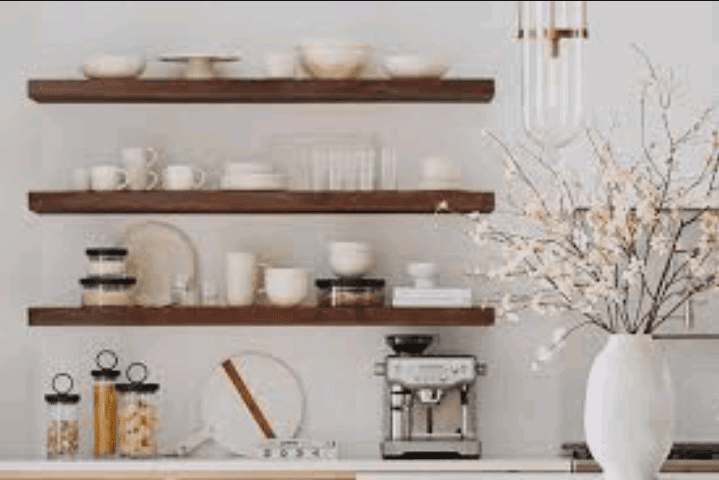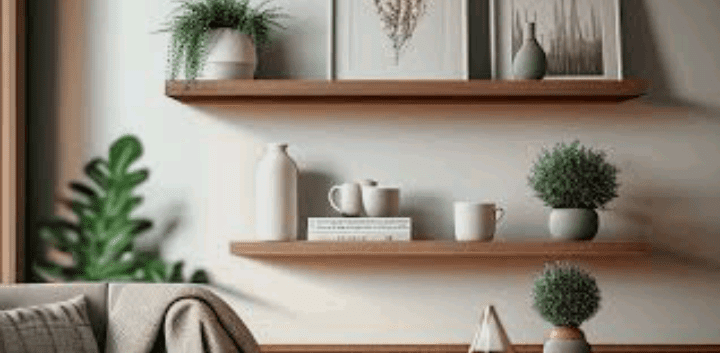DIY floating shelves are a fantastic way to spruce up your living space while adding practical storage. These versatile shelves not only declutter your home but also serve as stylish displays for your favorite decor items.
With a few basic materials and some handy tools, creating your own floating shelves is an accessible and enjoyable project for DIY enthusiasts of all skill levels.
Whether you’re a seasoned craftsman or just starting out, this article will guide you through the process step by step, making the construction of these shelves a simple and rewarding task.
Imagine a shelf that seems to magically hover on your wall, showcasing your beloved books, plants, or collectibles without any visible support. That’s the beauty of floating shelves. They add a touch of modern elegance to any room, offering a clean and uncluttered look that’s both practical and visually appealing.
In the following sections, we’ll explore everything you need to know about crafting your own floating shelves. From the essential materials and tools required to the step-by-step construction process, this guide will walk you through each stage.
Whether you want to add extra storage in the living room, display decorative pieces in the bedroom, or organize the kitchen, these shelves can be customized to suit any space and style.
By understanding the fundamentals of floating shelves, such as their purpose, design versatility, and the illusion of suspension, you’ll gain insight into how they can transform a room’s aesthetic.
Moreover, we’ll delve into the crucial aspects of preparation, installation, and securing the shelves to ensure a stable and visually appealing result.
Furthermore, we’ll explore the creative side of floating shelves—ideas to style and accessorize them, ways to personalize the design, and considerations for additional support or lighting.
The aim is to empower you to not only construct these shelves but also to embellish them in ways that suit your individual taste and the ambiance of your home.
Whether you’re looking to embark on your first DIY project or seeking to enhance your carpentry skills, crafting your own floating shelves is an enriching and achievable undertaking.
Join us in this exploration of creativity and functionality, and discover how these shelves can become a signature element in your home decor.
Read Also: DIY Meaning: Unveiling the Power of Do It Yourself
DIY Floating Shelves

I. Understanding Floating Shelves
Floating shelves, also known as wall-mounted shelves, offer a sleek and minimalist look that appears to “float” on the wall without visible brackets or supports. They can be crafted in various sizes, shapes, and materials, allowing for customization to suit different spaces and styles.
These shelves not only provide storage but also serve as decorative elements that can showcase cherished items, books, plants, or any other decor accents.
II. Materials and Tools Required
Before going into the construction process, gather the necessary materials and tools:
Materials:
Wood: Opt for a sturdy, durable wood type such as pine, oak, or walnut.
Floating shelf brackets or concealed mounting hardware
Wood screws
Wood glue
Sandpaper
Wood stain or paint (optional)
Tools:
Measuring tape
Level
Pencil
Saw (circular saw or handsaw)
DrillScrewdriver
Paintbrushes or staining materials
Safety gear (safety goggles, gloves, and a dust mask)
Read Also: Organizing the Outdoor Learning Environment
III. Step-by-Step Construction Process
a. Design and Measurement: Plan the dimensions and design of your shelves. Consider the space where you intend to install them.
Measure and mark the wall to determine the placement of the shelves. Use a level to ensure accuracy.
b. Wood Preparation: Cut the wood to your desired shelf size using a saw. Sand the edges and surfaces for a smooth finish.
If you wish, stain or paint the wood to match your interior decor. Allow it to dry completely.
c. Mounting Hardware Installation: Fix the floating shelf brackets or concealed mounting hardware onto the wall. Ensure they are level and properly secured.
Follow the manufacturer’s instructions for installation.
d. Attaching the Shelves: Apply wood glue to the area of the shelf that will attach to the hardware.
Carefully place the shelf onto the mounted hardware, ensuring a secure and snug fit. Use a level to confirm that the shelf is perfectly horizontal.
e. Securing the Shelves: After the glue has dried, reinforce the attachment by drilling wood screws through the shelf into the mounting hardware for added stability.
IV. Design Ideas and Finishing Touches
Now that your floating shelves are securely installed, consider these design ideas and finishing touches to enhance their appearance:
a. Styling and Organization: Arrange books, plants, photo frames, or decorative items on the shelves. Play with different arrangements to create an aesthetically pleasing display.
b. Lighting: Install LED strip lights or small, discreet spotlights underneath the shelves to illuminate the items on display, adding a subtle ambient glow to the space.
c. Personalization: Add personal touches by incorporating small decorative elements or incorporating unique designs like asymmetrical shelf arrangements or different shapes.
d. Additional Support: For heavier items, consider additional support by attaching L-shaped brackets under the shelves for extra security.
V. Maintenance and Care
To ensure your floating shelves remain in optimal condition:
Periodically check the shelf attachments and hardware to ensure they are secure.
Dust the shelves regularly to maintain their cleanliness and appearance.
Avoid placing excessively heavy items on the shelves that could compromise their stability.
Read Also: Everything You Need to Know About Trash Pickup in Philadelphia
